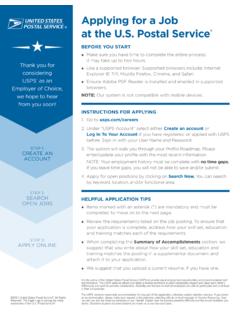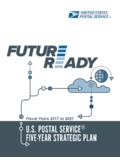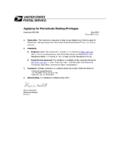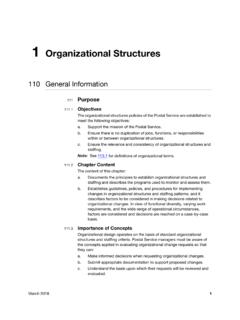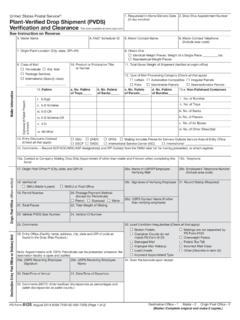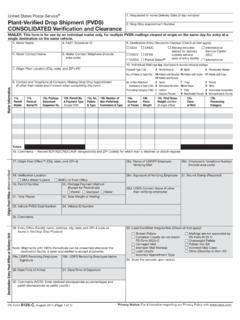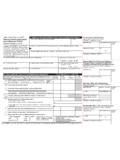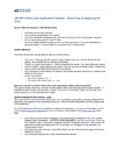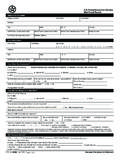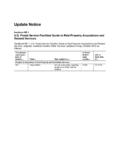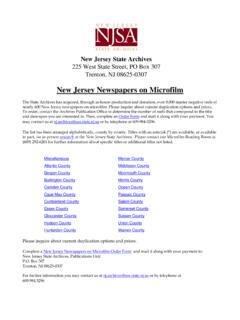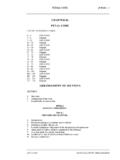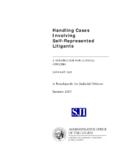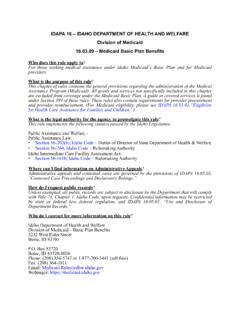Transcription of Stamped Cards and Postcards - USPS
1 1 Stamped Cards and Postcards Stamped Cards , called postal Cards prior to 1999, refer to mailing Cards issued by the Postal Service with postage stamps imprinted on them. Postcards refer to privately printed and sold Cards that require a stamp for mailing. In popular usage, the terms postal card and postcard (also spelled post card) were often used interchangeably. Postal Cards First Issued in the United States in 1873 In October 1869, Austria became the first country to issue mailing Cards imprinted with postage stamps, called postal Other European countries soon followed Austria in issuing postal Cards , to overwhelming public response. In November 1870, pointing to the success of postal Cards in Europe, Postmaster General John Creswell recommended to Congress the issuance of a one-cent postal card in the United States.
2 Creswell told Congress that there had long been a need for a "prompt and easy mode of communication by mail, adapted to the convenience and habits of business men, as well as of that large class of persons who have not the time or the inclination to write formal letters."2 In 1871, Representative John Hill of New Jersey introduced a bill in Congress authorizing postal Cards , but approval was delayed, due in part to concerns about the privacy of messages. James Garfield, a representative from Ohio (and later, President), thought that open messages on Cards would be too dangerous. By passing through so many hands, he thought that a postal card with a libelous message might "be a vehicle of great injury to the person to whom it was addressed.
3 "3 Garfield warned a colleague that he might "find these postal Cards coming back upon him like barbed arrows, from anybody who may wish to shoot at him."4 Garfield, among others, wanted a postal card constructed with a cover or gummed flap to conceal the message. After much debate, Congress left it to the Postmaster General to determine the proper form and size of the card. The Act of June 8, 1872, authorized the Postmaster General to issue postal Cards for the "transmission .. at a reduced rate of postage, of messages, orders, notices, and other short communications" on "good stiff paper, of such quality, form, and size, as he shall deem best adapted for general use."5 Through an oversight, Congress did not simultaneously appropriate funds for their manufacture; this was rectified by the Act of January 8, 1873.
4 Two weeks later, the Post Office Department advertised for bids, and on March 28 awarded the contract for postal card production to the lowest bidder, the Morgan Envelope Company of Springfield, Massachusetts. After a flurry of printing activity, the first postal Cards were ready to be shipped to Post Offices in May. The first postal Cards went on sale in Springfield, Massachusetts, on May 12, 1873, and in other cities the next day. The card measured three inches by five and one-eighth inches and had a one-cent stamp impression ("indicium") in the upper right corner. The indicium bore a profile of the Goddess of Liberty surrounded by a lathe-work border, with the words " POSTAGE" above and "ONE CENT" below.
5 The other side of the card, intended for the message, was entirely plain. The card was light buff in color, and the ink, brown. At a penny each, the Cards cost only a third as much as the 3-cent stamp for a The public responded enthusiastically. On May 14, 1873, the day after the first postal Cards were issued in New York, The New York Times reported that the city's postal clerks sold 200,000 Cards in two and a half hours. In their first week of issue, The New York Times tested the delivery of postal Cards by directing reporters to mail twelve Cards from and to various addresses in the city. Ten Cards , mailed in the morning, were delivered the same day; two that were deposited in collection boxes after noon were delivered before noon on the next 1 Postal Cards were first proposed by a German postal official, Heinrich von Stephan, in 1865.
6 Von Stephan proposed the idea chiefly "to dispense with the ridiculous length of titles, complimentary phrases, and mock servility of address, which, for some centuries, had encumbered German correspondence" (The American Exchange and Review, July 1875, 230-231). His idea was not adopted at that time; Germany issued its first postal Cards in July 1870. 2 Annual Report of the Postmaster General, 1870, 32. 3 The Congressional Globe, 2nd Session, 42nd Congress, April 9, 1872, 2301. 4 Ibid. In 1881, in the first year of his Presidency, Garfield was shot by a disappointed office-seeker and died from his wounds. 5 17 Stat. 304. 6 Because of their price, postal Cards were often popularly called "penny Postcards ." Except for a 20-month period during World War I, postal Cards cost only a penny to purchase and mail until January 1, 1952, when the price rose to 2 cents.
7 7 New York Times, May 19, 1873, 8. Prior to 1950, city letter carriers commonly collected and delivered mail several times daily. 2 Table 1: Number of Postal Cards Issued from 1875 to 1910 Year Number Issued 1875 107,616,000 1880 272,550,500 1885 339,416,500 1890 429,515,350 1895 492,305,550 1900 587,815,250 1905 728,584,550 1910 726,441,000 Source: Annual Report of the Postmaster General for listed years Preprinted Postal Card, 1882 Postal card mailed from Boston metalware dealers crediting the account of E. Plouff & Son, tinsmiths, for the sale of a water pitcher on September 15, 1882. Nationwide, customers bought 31 million postal Cards by June 30, 1873, and more than 64 million by the end of September. In October 1873, the publishers of The Atlanta Constitution announced that they could "furnish parties with postal Cards in any quantity with their business circular or other matter printed on them.
8 "8 Some businesses purchased Cards by the thousands and had them preprinted with advertisements or fill-in-the-blank messages, simplifying communications with customers and colleagues. Banks mailed postal Cards to customers, acknowledging deposits; libraries used them to send overdue book notices; and merchants and wholesalers used them to advertise prices. In 1875, more than 100 million postal Cards were issued (see Table 1, "Number of Postal Cards Issued from 1875 to 1910," on this page). Postal Cards were popular with individuals as well some critics thought they were too popular. In 1903, a writer for the Baltimore Sun lamented that "there are people who would write anything on a 'postal,' from a recipe for fruit cake to the last quarrel that they had with their husbands.
9 "9 In 1911, Elizabeth Van Rensselaer, etiquette columnist for the Chicago Tribune, advised: "As a general rule, a postal card should not be used except for business purposes.. If it is an absolute necessity to send one to a friend .. the sentences should be short.. all personal messages should be omitted."10 The annual number of postal Cards mailed peaked in 1950 at more than billion. They remained more popular than Postcards until the mid-1960s. (See Table 2, "Number of Postal Cards and Postcards sent Via First-Class Mail, 1930 to 1995," on page 4.) On May 4, 1956, the Post Office Department issued a postal card with an indicium that was novel in two ways it was bi-colored, and did not feature a human portrait.
10 This unique card, which was first issued at the Fifth International Philatelic Exhibition, had an indicium featuring the torch and arm of the Statue of Liberty in a triangular carmine red frame with violet blue writing. Ten years later, on May 27, 1966, the Department issued its first postal card with illustrations on the back (address) side at the Sixth International Philatelic Exhibition. This 11-cent international postal card featured the phrase "Visit the USA" in the indicium and four American scenes on the left side of the back. On July 29, 1972, the Postal Service issued its first postal Cards with pictures on the front. Each of the five Cards in the Tourism Year of the Americas '72 postal card set featured scenes of five tourist attractions four on the front and a fifth in the indicium on the other side.
